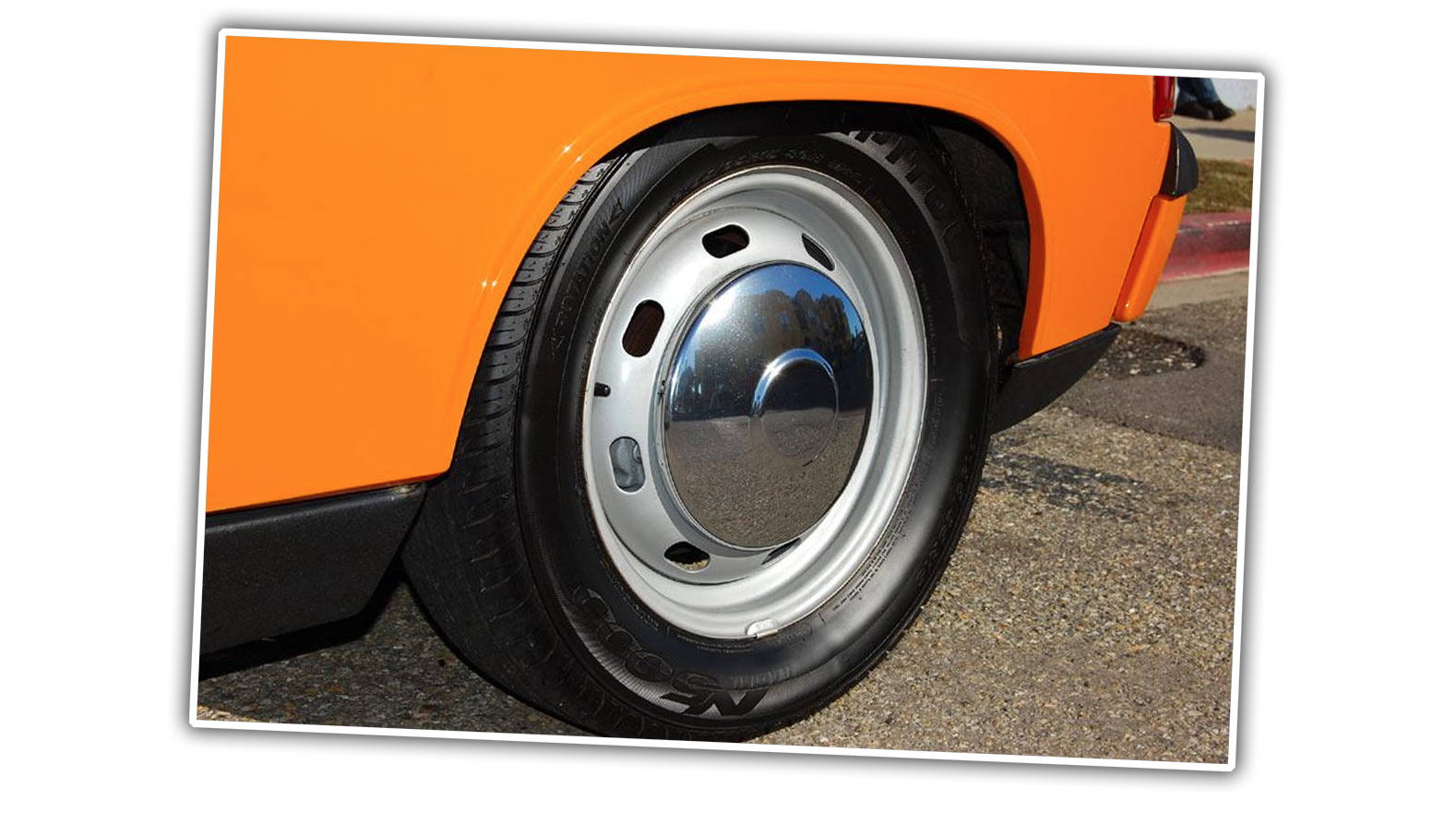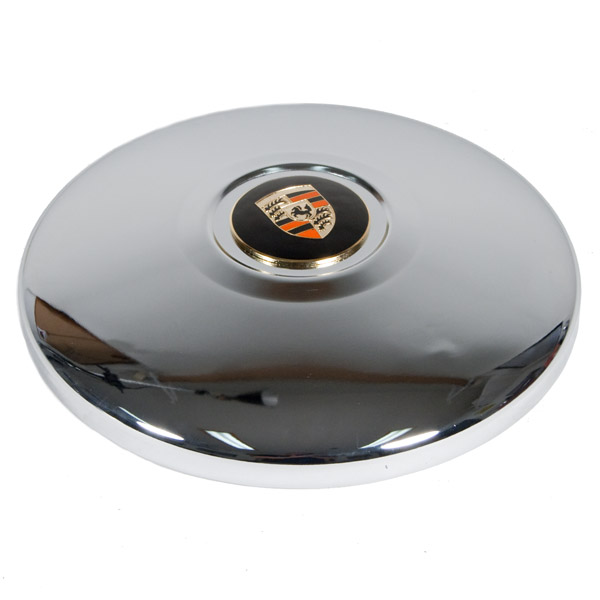I know the Porsche 914 is often derided–I think unfairly–by Porsche purists as being somehow unworthy of the elevated status that comes with having that Porsche badge adhesive’d onto the body. But part of the blame for this is on Porsche itself, who, via a combination of penny-pinching and insecurity, cast the 914 in suspect light from the get-go. There’s really no better place to see this than on the wheels used on the 914, which came from what was literally one of the cheapest cars you could buy at the time.
Personally, I kind of love that Porsche did that. The wheels are, in a purely rational sense, just fine for the job. But, what makes this all so fascinating to me is just how deliriously unacceptable this would be today, which is sort of the theme of this occasional series we’re starting here, called Phoning It In.
Phoning It In will be about the amazing ways that carmakers have half-assed any number of things. We’ll be looking at stunning examples of not-give-a-shittery through modern eyes, and just revelling in the knowledge that, at one time, these sorts of things were thought to be acceptable.
It’ll be fun. You’ll see. (And if you have any examples, email them to me at jason@autopian.com).
Anyway, to really appreciate today’s phone-in job, we need to give a brief primer on the Porsche 914 and why it existed.
The 914 came about because of an interesting intersection between two sorta-related companies, Volkswagen and Porsche. VW was, of course, a mass-market, affordable car maker, and Porsche was a builder of exclusive, premium sports cars. But the circles in the Venn diagram of the two companies had a small bit of overlap, where VW had its premium, top-of-the-line sports car offering, and where Porsche had its entry-level, base car.
For VW the car was the Type 3 Ghia, and for Porsche the car was the 912. The 912 was a 911 with the smaller four-cylinder engine carried over from the 356 instead of the newer flat-six on the full 911, making it Porsche’s cheapest car.
The VW Type 3 Ghia, also called the Type 34 Ghia, used the midrange Type 3 platform and flat-four engine, but with a unique and handsome body designed by Italian styling/coachbuilding company Ghia, similar to how the Type 1 Karmann Ghia was a Beetle with a prettier outfit.
Both of these cars were on their way out; since VW had a contract with Porsche from way back to handle some engineering work, it made sense for both companies to develop one car that covered both niches: a top of the line halo car for VW and a cheap way to get into something from Stuttgart’s most legendary sportscar maker. 
The result of this joint effort was the Porsche 914. In Europe, there was some interesting, arguably more honest, branding of the car as a VW-Porsche 914, but here in America, it was just sold as a Porsche — no brand qualifiers at all.
The basic 914 was developed by Porsche but used plenty of VW components, including some switchgear and, significantly, the new Type 4 engine — though there was a potent and uncommon Porsche variant with the 911’s flat-six, too.
Okay, so, by 1969 the 914 was released, and, at least in America, it was badged and sold as a Porsche. Here’s where we get to the part that I find fascinating, and, when viewed from the perspective of modern Porsche, baffling.
These were the base wheels the car came with:

They’re not so bad, right? They’re clean, simple…maybe a little strangely simple. And kind of familiar.
Why so familiar?

They were familiar because they were the exact same wheels and hubcaps that Volkswagen had been using on Beetles—really, almost all its cars—since 1968, when this particular four-lug steel wheel with hubcap design was introduced.
They weren’t exactly the same, though. If you look closely, you can see one notable difference:

(photo: californiaclassix.com)
Yes, no VW logo! Because, of course, this is a Porsch-uhhhh, not some common, cheap-ass VW! And, as a result of that Porsche decided to give the 914 a fitting wheel: one from one of the absolute cheapest cars you could buy on the US market, just, you know, with less work put into it.
It’s not so much the basic wheel design that amazes me, it’s the choices Porsche made with the hubcap. Would it have killed them to put the Porsche badge on there? Stamp it in, at least? Do, you know, anything?
The aftermarket has been making such hubcaps for years and years, so we know there’s no technical reason that somehow a Porsche badge couldn’t be put on these:

It’s possible, via some black magic known as “sticking it on there,” so I’m pretty sure Porsche could have figured it out, and I bet it wouldn’t even have jacked up the price that much.
There’s something about the obviousness of the borrowing and the incredibly brazen half-assed attempt to hide it by eliminating the stamped logo. It’s somehow worse without the logo, as it feels even more generic, like someone shot them with that advanced ray they use for insurance ads to de-identify a car.
In the 914’s first year, 1969, the car cost $3,595 for the base model. A 1969 Beetle only cost $1,799. Literally half the cost of the car, and they came with visually the same wheels. Maybe no one cared back then? I can find effectively no period-era criticisms directly about this, but today, even for an entry-level Porsche, this would be absolutely impossible to imagine.
Just think if the base model Boxster came with the same wheels used by the Mitsubishi Mirage, but it was okay because Porsche had them leave the Mitsubishi logo off when they ordered them. See? It’s fine!
Nobody would be okay with that today.
Porsche later used VW’s sportier steel wheels from 1974 to 1976, and these were still ones used on cheap Beetles, but they did look a bit slicker:
Of course, there were many, many other wheel options for 914s, so if you wanted to spend a little extra and be a big shot, you could have a Porsche without four very obvious parts from the world’s most famous economy car.
If I had a 914, I would absolutely want the generificated-Beetle hubcap wheels. Because it’s an artifact of a time that will absolutely never come again, and this kind of forgotten half-assery needs to be cherished.







You could do one of these on the interior door latches of the Citroën Dyane. It was supposed to be an upmarket 2CV, so it had more black plastic on the inside of the doors, but to open the doors you had to put your fingers into a rough cut-out in that plastic and find a steel rod, connected to the door latches. They were all pointing downward, so you could never see what was going on in there. Really felt nasty.
Oh and the Dyane also had a mild facelift, by mounting the door handles upside down at some time! So that’s actually 2 phone-ins on one car!
It also had a clever way of forcing some of the air from the air cooling fan into the carburetor, a sort of mild compressor, so it had a few more horsepower than the stock 2CV.
There’s always a lot of not thought through laissez-faire solutions on old Citroëns. On my DS, two of the most fun are the rubber plugged hole in the rain gutter below the windscreen to acces spark plug number four (so you hit the windscreen with your spanner almost every time), and the fact that the high pressure expansion hose (of course it has no tank..) ends right above the right front disc brake. So if you were in the mountains and it cooked over, you were blessed with also suddenly having a lot less braking…
Dear Jason.
Having read your articles for more than a decade (which is equal to 137 internet years) I am so glad to see this site up and running.
The last half of this decade has been the most unstable period in my personal life, deaths, divorce, restructured work life, all just happening without me having a say. As an adult, I am aware that “that’s life”, but sometimes, what pulls you through is to spend some time dwelling on the more stable things in life, and your writing falls into this category.
I do not have to agree or disagree with your findings to make them well worth a read, but one thing that I am so far really happy to see, is the lack of what I consider to be structured Elon bashing.
This leads me to one question that you may not be willing or perhaps legally allowed to talk about:
Is there a quota for negative Elon articles on the old Gawker sites?
One wink for no, two for yes.
Correct me if I’m wrong but didn’t they use these on the 356, and on long hood 911s and 912s also? If not these exact wheels, the non-Fuchs option on the early cars was extremely similar.
I mean, they look good though.
As a kid, Porche’s use of these hubcaps confused me. I mean, really badly. To the point that I drew the (incorrect?) conclusion that this model was actually a VW. I blame most of my adult psychological dysfunctions on Porche’s decision.
One of those dysfunctions is my inability to correctly spell “Porsche.”
Your not-a-Porsche conclusion was pretty spot on, really.
Well, in Europe, the 914 was badged as a VW / Porsche (with the VW logo displayed prominently on the rear), so this is less about Porsche phoning in the hubcaps and more about VW and Porsche deciding to go with the more upscale brand in the USA to fool those American philistines.